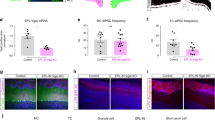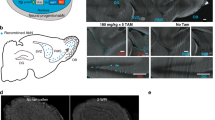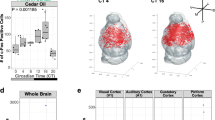Abstract
How wakefulness shapes neural activity is a topic of intense discussion. In the awake olfactory bulb, high activity with weak sensory-evoked responses has been reported in mitral/tufted cells (M/TCs). Using blind whole-cell recordings, we found 33% of M/TCs to be 'silent', yet still show strong sensory responses, with weak or inhibitory responses in 'active' neurons. Thus, a previously missed M/TC subpopulation can exert powerful influence over the olfactory bulb.
This is a preview of subscription content, access via your institution
Access options
Subscribe to this journal
Receive 12 print issues and online access
$209.00 per year
only $17.42 per issue
Buy this article
- Purchase on Springer Link
- Instant access to full article PDF
Prices may be subject to local taxes which are calculated during checkout


Similar content being viewed by others
References
Haider, B., Häusser, M. & Carandini, M. Nature 493, 97–100 (2013).
Kato, H.K., Chu, M.W., Isaacson, J.S. & Komiyama, T. Neuron 76, 962–975 (2012).
Gschwend, O., Beroud, J. & Carleton, A. PLoS ONE 7, e30155 (2012).
Shusterman, R., Smear, M.C., Koulakov, A. & Rinberg, D. Nat. Neurosci. 14, 1039–1044 (2011).
Cury, K.M. & Uchida, N. Neuron 68, 570–585 (2010).
Fuentes, R.A., Aguilar, M.I., Aylwin, M.L. & Maldonado, P.E. J. Neurophysiol. 100, 422–430 (2008).
Kay, L.M. & Laurent, G. Nat. Neurosci. 2, 1003–1009 (1999).
Rinberg, D., Koulakov, A. & Gelperin, A. J. Neurosci. 26, 8857–8865 (2006).
Doucette, W. & Restrepo, D. PLoS Biol. 6, e258 (2008).
Blauvelt, D.G., Sato, T.F., Wienisch, M., Knöpfel, T. & Murthy, V.N. Front. Neural Circuits 7, 46 (2013).
Wachowiak, M. et al. J. Neurosci. 33, 5285–5300 (2013).
Davison, I.G. & Katz, L.C. J. Neurosci. 27, 2091–2101 (2007).
Shoham, S., O'Connor, D.H. & Segev, R. J. Comp. Physiol. A Neuroethol. Sens. Neural Behav. Physiol. 192, 777–784 (2006).
Margrie, T.W., Brecht, M. & Sakmann, B. Pflugers Arch. 444, 491–498 (2002).
Wohrer, A., Humphries, M.D. & Machens, C.K. Prog. Neurobiol. 103, 156–193 (2013).
Pager, J. Brain Res. 289, 87–98 (1983).
Bhalla, U.S. & Bower, J.M. J. Comput. Neurosci. 4, 221–256 (1997).
Matsumoto, H., Kashiwadani, H., Nagao, H., Aiba, A. & Mori, K. J. Neurophysiol. 101, 1890–1900 (2009).
Balu, R., Pressler, R.T. & Strowbridge, B.W. J. Neurosci. 27, 5621–5632 (2007).
Dietz, S.B. & Murthy, V.N. J. Physiol. (Lond.) 569, 475–488 (2005).
Fukunaga, I., Berning, M., Kollo, M., Schmaltz, A. & Schaefer, A.T. Neuron 75, 320–329 (2012).
Cazakoff, B.N., Lau, B.Y.B., Crump, K.L., Demmer, H.S. & Shea, S.D. Nat. Neurosci. 17, 569–576 (2014).
Abbott, L.F., Varela, J.A., Sen, K. & Nelson, S.B. Science 275, 220–224 (1997).
Boegerhausen, M., Suter, P. & Liu, S.-C. Neural Comput. 15, 331–348 (2003).
Cang, J. & Isaacson, J.S. J. Neurosci. 23, 4108–4116 (2003).
Acknowledgements
We thank M. Kaiser, E. Stier, S. Bellanca, P. Hasel and M. Karageorgi for technical assistance, N. Neef and M. Lukat for building the treadmill and headplates, and R. Jordan for help with behavioral experiments. We also thank D. Gire, R. Haddad, L. Kay and D. Rinberg for discussion, and T. Margrie, Z. Nusser and D. Burdakov for comments on the manuscript. This work was supported by the Excellence Cluster Cell Networks (postdoctoral fellowship to M.K.), the Max Planck Society, DFG (SPP1392), the Medical Research Council (MC_UP_1202/5), and the Alexander von Humboldt foundation (postdoctoral fellowship to I.F.). A.T.S. is a member of the Interdisciplinary Center for Neuroscience and the Bernstein-Center.
Author information
Authors and Affiliations
Contributions
M.K. and A.T.S. designed and conceived all of the experiments. A.S. designed the headplate and the treadmill. M.K. performed the awake recordings and the computational analyses. M.K. and I.F. carried out the anesthetized experiments. M.A. performed the behavioral experiments. M.K. and A.T.S. analyzed and interpreted the data and modeling results. M.K. and A.T.S. wrote the article with contributions from all authors.
Corresponding authors
Ethics declarations
Competing interests
The authors declare no competing financial interests.
Integrated supplementary information
Supplementary Figure 1 Odor discrimination performance after experimental procedures
To confirm that following awakening after surgery mice were fully alert and capable of odor discrimination, in a small group of animals, we assessed the effect of surgery on performance in a go/no-go odor discrimination task. (a) The temporal sequence of surgeries and training. Within three to seven days from the first surgery, mice were trained to discriminate three pairs of odors until near-perfect discrimination. (b, c) In the head-fixed design, mice were presented with odor stimuli. A light cue was presented to indicate the beginning of a new trial. The licking response was measured by a photodiode based lick-sensor. (d) Learning curves in three mice. Gray bars indicate trials with automatic reward, in the rest of the trials, the reward was initiated by licking activity. (S+ odors: purple, S- odors: orange). (e) Odor discrimination performance before (closed circles) and after (open circles) craniotomy in four example animals. Following surgery (in the recording arrangement) animals were still capable of near-perfect discrimination performance (94±3 %, n = 4 animals). (f) The effect of silencing the OB by superfusing 10 mM muscimol over the exposed OB onto odor discrimination performance. (g) Patch-clamp recording from an M/T cell during an odor discrimination task. The animal shows suppression of licking activity during S- trials and licking response during S+ trials. Similarly to the awake, passive case, phasic excitatory responses as well as hyperpolarized, "silent" cells were observed (see Supplementary Fig. 3, Fig 1f).
Supplementary Figure 2 Classification of in vivo recorded neurons
(a) The waveform of the after-potential of the average AP from each recorded neuron was used for unsupervised classification. The black lines represent factor loadings for the three factors characterizing the after-potential, which were used for the classification of recorded neurons. (b) Average spike waveforms of the morphologically identified neuron classes. (MC – mitral cell, TC – tufted cell, GC – granule cell, PGa and PGb are PG cells showing after-depolarization and after-hyperpolarization, respectively). (c) Hierarchical clustering of in vivo recorded neurons. Colored labels denote the morphologically identified principal and interneurons. The average spike shapes are displayed for all cells on the same branch (black traces). (d) Separation of M/T cells (red and orange) and interneurons (blue and green) along the three factors. (Colored dots indicate morphologically identified cells, color codes are the same as in b). (e) Silent M/T cells (black dots; < 0.1Hz) are distributed evenly in the factor space within the M/T cell group. (f) Comparison of cellular properties of silent (< 1 Hz baseline firing rate), and active (≱ 1 Hz baseline firing rate) M/T cells.
Supplementary Figure 3 Odor-evoked responses in M/T cells
Odor responses in anesthetized (a) and awake (b) animals. Significant excitatory/inhibitory responses are shown in green/red respectively. Odor pulses recorded in behaving animals during odor discrimination task are encircled. Pre-odor firing rate was measured during a 1 second period before odor presentation as described in the methods. Points were randomly displaced by a small amount on the x-axis to allow better visual discrimination of the individual data points.
Supplementary Figure 4 Odor-evoked responses in anesthetized mice
(a) Example traces of odor-evoked responses in four M/TCs recorded in anesthetized mice. The respective average baseline membrane potential is indicated to the left of each trace (in mV). (b) Histogram of odor response amplitudes. (c) Relationship between recent firing behavior and odor-evoked responses. (mean and 25th and 75th percentile). (d) Cumulative distribution curves displaying the dependence of the odor response profiles of M/T cells on recent membrane potential. (n = 1723 odor trials, 76 cells from 49 animals; cf. Fig. 2).
Supplementary Figure 5 Long-lasting odor responses in M/T cells
(a) Delayed, long-lasting odor-evoked excitatory responses in anesthetized animals. Note that the signs of short-term and long-term firing rate changes can be different. (b) In awake animals, odor-evoked changes of neuronal activity in the late phase are infrequent and weak. (c) Odor-evoked responses in different time intervals after odor onset in the anesthetized (top panel) and awake (bottom panel) state (mean ± SE).
Supplementary Figure 6 Predicted excitatory odor responses in granule cells are tightly correlated with recent presynaptic mitral/tufted cell activity
Estimation of the excitatory current responses in GCs receiving input from different M/TCs using a simple model employing measured synaptic dynamics. (a) Simulated synaptic currents in a GC upon repetitive activation in a synaptic depression model of the M/T - GC synapse. At a firing rate of 50 Hz, the calculated postsynaptic currents reach a steady state amplitude of 22.5% of the initial value (depression coefficient d = 0.65, time constant of recovery from depression τd = 100 ms; cf. refs. 19, 20). (b) Three examples of simulated EPSCs in GCs (gray traces) receiving input from presynaptic principal neurons (black traces) with different temporal patterns. Presynaptic spike trains were taken from measured M/TC firing in awake mice (cf. Fig 2). Due to the synaptic plasticity, EPSCs in a GC receiving input from a highly active M/T cell (right) are depressed during the odor pulse (gray area). Inputs from an initially silent M/T cell (left) are substantially less suppressed. (c) Synaptic inputs received by GCs during different presynaptic M/T activity. Dots represent individual odor stimulation trials measured in awake mice. Each dot corresponds to a M/TC response measured in the awake animal with relative charge transfer modelled as in a, b. The color of dots indicates the sign and amplitude of the odor response in the presynaptic M/T cell. Both low firing rate and high firing rate neurons deliver several pA of average current to GCs during the first second of the odor stimulus. Remarkably, however, the average excitatory postsynaptic response in GCs to odorants correlates strongly with the firing rate of the presynaptic M/TC (p = 0.00009, ρ = 0.399, Spearman's rank correlation), suggesting that substantial increases of the excitatory drive in response to odorants are only reached at synapses from M/TCs with low baseline spiking activity. M/TCs with high firing rates on the other hand typically reduce excitatory input to post-synaptic GCs upon odor stimulation and are unlikely to provide additional excitation needed to recruit GCs. The strength of the correlation only moderately depends on the rate of recovery from depression, while the results are qualitatively unchanged even with the shortest time constant mentioned in the literature (37 ms, ref. 20). In the absence of synaptic depression, the recent presynaptic firing rate and the postsynaptic response are still correlated, but the correlation is substantially weaker (ρ = 0.197).
Supplementary Figure 7 Odor-evoked responses in interneurons
(a) Predicted distribution of odor responses in interneurons based on the synaptic model (Supplementary Fig. 6). In anesthetized animals (top, blue) a larger proportion of synapses shows increased excitation. In awake animals (bottom, gray), due to the larger number of highly active principal neurons, decrease in excitation in INs (labeled “inh”) is predominant (median in anesthetized: ‑0.04 pC, awake: 0.04 pC; p < 0.0001 MW-U test; c.f. Supplementary Fig. 6c). Note the inverted abscissa: the strongest excitatory responses are on the right. (b) Recorded odor-evoked responses from interneurons show largely excitatory responses in the anesthetized (n = 91 cells from 60 animals) and mostly inhibitory responses in the awake state (median in anesthetized: 0.45 mV, awake: ‑0.12 mV; p < 0.0001 MW-U test; n = 435 odor trials from 48 interneurons from 38 animals in awake and n = 1504 odor trials from 91 interneurons from 60 animals in anesthetized).
Supplementary Figure 8 Schematic of the finding
(a) M/T cell firing rates show great heterogeneity during rest. (b) During olfactory sensory input, initially inactive M/T cells (blue) recruit GCs by providing strong excitatory synaptic inputs (black arrows). Initially active M/T cells (red and magenta) fail to activate more GCs, both due to their tendency to decrease firing rate upon sensory stimuli (magenta), and due to short term depression of their synapses to GCs (red). Yellow symbolizes neuronal activity.
Supplementary information
Supplementary Text and Figures
Supplementary Figures 1–8 and Supplementary Table 1 (PDF 1649 kb)
Rights and permissions
About this article
Cite this article
Kollo, M., Schmaltz, A., Abdelhamid, M. et al. 'Silent' mitral cells dominate odor responses in the olfactory bulb of awake mice. Nat Neurosci 17, 1313–1315 (2014). https://doi.org/10.1038/nn.3768
Received:
Accepted:
Published:
Issue Date:
DOI: https://doi.org/10.1038/nn.3768
This article is cited by
-
Genetic influences of autism candidate genes on circuit wiring and olfactory decoding
Cell and Tissue Research (2021)
-
A unique olfactory bulb microcircuit driven by neurons expressing the precursor to glucagon-like peptide 1
Scientific Reports (2019)
-
Mixed-up mitral cells
Nature Reviews Neuroscience (2014)



